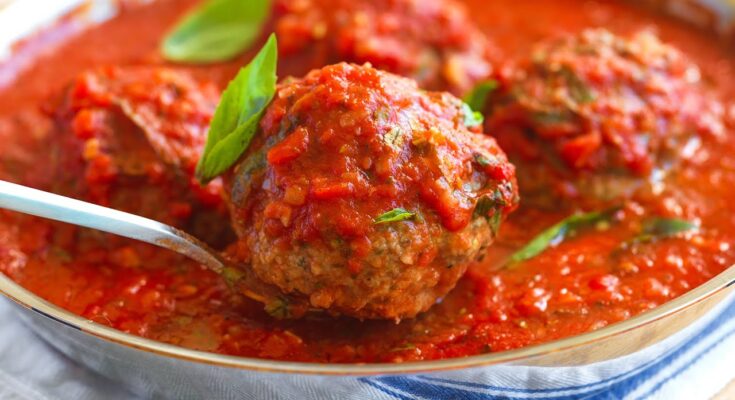Meatball Sauce Recipe: There’s something utterly comforting about a plate of tender meatballs smothered in a rich, savory sauce. But here’s the catch—no matter how juicy your meatballs are, they’re nothing without the right sauce. The sauce isn’t just an afterthought; it’s the soul of the dish. It ties everything together, adding moisture, deep flavor, and that irresistible aroma that makes people come running to the dinner table.
So, what makes a meatball sauce truly shine? It’s all about balance—balancing acidity from tomatoes, sweetness from aromatics, and richness from olive oil or butter. A well-crafted sauce doesn’t overpower your meatballs; it elevates them. Whether you’re cooking for a cozy family dinner or trying to impress guests, getting this sauce right can be your culinary ace.
In this guide, I’ll walk you through everything—ingredient selection, cooking techniques, simmering secrets, and even creative twists. Trust me, after reading this, you’ll never go back to jarred sauce again.
Ingredients You’ll Need
Before you turn on the stove, let’s talk ingredients. A great meatball sauce starts with fresh, flavorful components. Here’s what you’ll typically need:
Basic Ingredients:
- 2 tbsp olive oil
- 1 medium onion, finely chopped
- 4 garlic cloves, minced
- 2 cans (28 oz each) crushed tomatoes
- 2 tbsp tomato paste
- 1 tsp sugar (optional)
- 1 tsp salt (adjust to taste)
- ½ tsp black pepper
- 1 tsp dried oregano
- ½ tsp dried basil
- ¼ tsp red pepper flakes (optional)
- Fresh parsley or basil for garnish
Why Fresh Matters: Whenever possible, opt for fresh garlic and onions over pre-chopped. The flavor is sharper and more fragrant. If you have access to fresh herbs—like basil and parsley—use them! They add a vibrant touch to your sauce that dried versions just can’t match.
Canned vs. Fresh Tomatoes: Canned tomatoes are perfectly fine and actually preferred for consistency and flavor. San Marzano tomatoes, in particular, are the gold standard. However, if you’re a stickler for fresh produce, peel and puree about 3 pounds of ripe Roma tomatoes as a substitute.
Optional Add-Ins: Want to spice things up or create a more robust sauce? Consider adding:
- A splash of red wine
- A pinch of smoked paprika
- A dash of Worcestershire sauce
- Grated parmesan
Your pantry is your playground, but remember: keep the core balanced.
Preparing the Perfect Base
Now that we have our ingredients lined up, let’s get into the most crucial phase—building your sauce base. This step sets the tone for the entire dish.
Step 1: Heat the Oil
Use a large saucepan or Dutch oven. Heat 2 tablespoons of olive oil over medium heat. You want it hot enough to sizzle, but not smoke.
Step 2: Sauté the Aromatics
Add the chopped onions first. Cook them slowly—this isn’t a race. Stir occasionally and let them soften and turn golden, which takes about 7–10 minutes. The goal is caramelization, not browning. This draws out the sweetness and forms a flavor foundation.
Next, toss in your minced garlic. Stir it continuously for 1–2 minutes. Be vigilant—garlic burns fast, and burnt garlic will give your sauce a bitter taste.
Why It Matters: This is where flavor layers begin. Rushing this step is like trying to bake a cake without preheating the oven. The depth of flavor in your final sauce hinges on a slow, flavorful sauté.
Building Rich Flavor
With your base ready, it’s time to start crafting the core of the sauce. This is where the magic happens.
Step 1: Add Tomato Paste
Stir in about 2 tablespoons of tomato paste. Let it cook for 2–3 minutes. Cooking tomato paste brings out its natural sweetness and adds a rich umami punch.
Step 2: Introduce Crushed Tomatoes
Pour in the canned crushed tomatoes. Stir well to combine everything in the pot. At this point, the sauce might seem a bit acidic and flat, but don’t worry—we’ll fix that with seasoning and time.
Step 3: Season Thoughtfully
Add your salt, pepper, oregano, basil, and red pepper flakes if you like a little heat. If your tomatoes are too acidic, a teaspoon of sugar can help balance things out. Stir and taste.
Why Seasoning Matters: Think of seasonings as your sauce’s personality. Herbs like oregano and basil bring in a classic Italian aroma, while red pepper flakes give it a kick. But don’t dump everything in at once—taste and adjust. Trust your palate.
Simmering to Perfection
Alright, you’ve built a flavorful base and added your seasonings. Now, it’s time to let the sauce work its magic through simmering.
Step 1: Let it Simmer
Turn the heat down to low and let your sauce simmer uncovered for at least 30–45 minutes. Stir occasionally to prevent sticking. This step allows flavors to meld and deepen.
Step 2: Watch for Consistency
You’re aiming for a sauce that’s thick enough to cling to meatballs but not so thick it becomes a paste. If the sauce thickens too much, add a splash of water or broth.
Step 3: Final Tasting
Once the sauce has simmered, taste again. Adjust salt, pepper, or herbs if needed. If you added wine earlier, you should notice a richer, more rounded flavor now.
Pro Tip:
Throw a few meatballs into the sauce during the final 10 minutes of simmering. This not only warms the meatballs but also infuses the sauce with extra meaty goodness.
Optional Add-Ins for Extra Flavor
You’ve got your classic sauce simmering, but let’s say you want to give it a little twist—something to make your guests go, “Wow, what’s in this?” That’s where optional add-ins come into play. These extras can take your meatball sauce from great to unforgettable.
Add Cheese for Richness
Parmesan, Romano, or even a touch of cream cheese can lend a silky texture and deepen the umami profile. Grated cheese dissolves into the sauce, making it thicker, richer, and creamier. Just add ¼ cup grated parmesan during the last 10 minutes of simmering.
Cream for a Velvety Finish
A splash of heavy cream (about ¼ cup) will turn your red sauce into a rosé delight. It’s perfect if you’re going for a smooth, luxurious feel that softens the acidity of the tomatoes.
Wine for Sophistication
Deglaze your pan with a splash of red wine right after sautéing the onions and garlic but before adding the tomato paste. Let it reduce for a couple of minutes. This brings out hidden flavors in the tomatoes and gives the sauce a mature depth.
Veggies for Substance
Chopped bell peppers, mushrooms, or even shredded carrots can sneak in more flavor (and nutrition). Sauté them with your onions to keep things cohesive.
Bonus Tip: Want a slightly smoky profile? Try a teaspoon of smoked paprika or a pinch of chipotle powder. Experimentation is how the best family recipes are born!
Best Meatballs to Pair with the Sauce
You’ve nailed the sauce—now let’s talk meatballs. A good meatball should be juicy, tender, and flavorful, and it should complement your sauce without overpowering it.
Homemade Wins Every Time
Store-bought meatballs are convenient, sure. But homemade? They’re unbeatable. Use a mix of ground beef and pork for optimal flavor. Add breadcrumbs soaked in milk, an egg for binding, and seasonings like parsley, garlic powder, onion powder, and grated parmesan.
Roll them evenly, about 1½ inches wide. Sear them in a hot pan until browned on all sides before transferring them into your simmering sauce. Let them cook together for the final 20–30 minutes—this blends flavors beautifully.
Cooking Directly in Sauce
You can also poach meatballs directly in your sauce without pre-cooking them. Drop them gently into the simmering sauce and cook covered for 30 minutes. This method keeps them extra moist but may make the sauce a bit fatty—skim the top if needed.
Vegetarian Meatballs
For a meat-free twist, try lentil or mushroom-based meatballs. They hold together well and absorb the sauce just like the classic version.
Texture Tip: Don’t overwork the meat mixture. Handle it gently to avoid tough meatballs. Your sauce deserves the best!
Storage and Reheating Tips
One of the best things about meatball sauce? It tastes even better the next day. But only if you store it right.
Refrigerator Storage
Once cooled, transfer the sauce (with or without meatballs) into an airtight container. It’ll stay fresh in the fridge for up to 4 days. Always let it cool to room temperature before refrigerating to avoid condensation.
Freezing for Later
This sauce freezes like a dream. Portion it into freezer-safe bags or containers, leaving a little space for expansion. It’ll keep for up to 3 months. Thaw overnight in the fridge before reheating.
Reheating Like a Pro
Reheat on the stovetop over medium-low heat. Stir occasionally to prevent sticking. You can also microwave it in bursts, but stovetop yields the best texture and flavor.
Pro Tip: Add a splash of water or broth when reheating to loosen up the sauce and revive that fresh-cooked feel.
Common Mistakes to Avoid
Even the best cooks can slip up. Here are some pitfalls to steer clear of when making meatball sauce:
1. Rushing the Simmer
Great sauce takes time. Skipping or shortening the simmering phase results in a flat, acidic taste. Always give your sauce at least 30 minutes, and ideally an hour, to bloom.
2. Using Cheap Tomatoes
Tomatoes are the backbone of this dish. Cheap or overly acidic canned tomatoes will sabotage your flavor. Stick with quality brands like San Marzano—your taste buds will thank you.
3. Overloading the Seasoning
It’s tempting to add “just a bit more” of everything, but over-seasoning can kill the natural flavor of tomatoes. Season slowly and taste often.
4. Burning the Garlic
This is a cardinal sin. Burnt garlic turns bitter and ruins your base. Always sauté it gently on low heat after onions are soft.
5. Skipping the Tasting Step
Every batch of tomatoes is different. Always taste your sauce before serving and adjust accordingly. Sometimes a pinch of sugar or a bit more salt can make all the difference.
Avoid these common errors, and your sauce will be foolproof every time.
Serving Suggestions
Sure, spaghetti and meatballs is the classic combo. But why stop there? This versatile sauce pairs well with more than just pasta.
Perfect Pasta Partners
- Spaghetti: The iconic choice.
- Penne or Rigatoni: Their tubular shape holds sauce like a dream.
- Zoodles or Spaghetti Squash: Great for low-carb lovers.
Bread Pairings
Serve it over toasted Italian bread or in a hoagie roll for a mouth-watering meatball sub. A little melted mozzarella on top? Chef’s kiss.
Creative Twists
- Pizza Sauce: Use it as a rich base on homemade pizza.
- Stuffed Peppers: Mix it with rice and fill inside bell peppers.
- Casseroles: Layer meatballs and sauce with cooked pasta and cheese in a baking dish and bake until bubbly.
Side Kicks
Add a green salad and garlic bread, and you’ve got a full Italian feast that would make Nonna proud.
Gluten-Free and Vegan Variations
Adapting a classic meatball sauce recipe for dietary needs doesn’t mean sacrificing flavor. Whether you’re going gluten-free, vegan, or both, there are plenty of creative options that still deliver on taste, texture, and satisfaction.
Gluten-Free Swaps
If you’re sensitive to gluten, you’ll want to watch out for two main ingredients: the meatballs and the tomato products.
- Breadcrumbs: Traditional meatballs use breadcrumbs for binding. Swap them out with gluten-free alternatives like almond flour, gluten-free oats, or crushed gluten-free crackers.
- Tomato Products: Most canned tomatoes are gluten-free, but always check labels for hidden additives or thickeners that might contain gluten.
And remember, pasta isn’t off the table. Try gluten-free pasta made from rice, corn, or lentils—they pair just as well with the sauce.
Vegan Sauce and Meatballs
The base tomato sauce is naturally vegan as long as you skip the cheese or cream. If you’re craving richness, opt for plant-based alternatives:
- Vegan Butter or Olive Oil for sautéing
- Cashew Cream instead of dairy cream
- Nutritional Yeast for a cheesy umami touch
Vegan Meatball Ideas:
- Lentil Balls: Cooked lentils, oats, garlic, onion, and flaxseed make a hearty base.
- Mushroom & Walnut Balls: Sautéed mushrooms, walnuts, and breadcrumbs blend into an earthy, satisfying alternative.
- Chickpea Balls: Chickpeas, tahini, and herbs are a Mediterranean twist you’ll love.
Whether it’s allergies, sensitivities, or lifestyle choices, you can still enjoy an amazing meatball sauce dinner—no compromises required.
Tools You’ll Need in the Kitchen
While the ingredients are the stars, the right tools can make your cooking smoother and more enjoyable. Think of your kitchen like a painter’s studio—you want all the right brushes at hand.
Must-Have Tools
- Large Saucepan or Dutch Oven: You need a roomy pot to let the sauce simmer without boiling over.
- Wooden Spoon: Ideal for stirring, especially when scraping up those delicious browned bits from sautéing.
- Sharp Chef’s Knife: Prepping onions, garlic, and herbs is faster and safer with a good knife.
- Cutting Board: Preferably two—one for veggies, another for meat prep.
- Garlic Press (Optional): If you want to save time mincing.
Time-Saving Gadgets
- Food Processor: Great for chopping onions or blending ingredients for vegan meatballs.
- Immersion Blender: Want a smoother sauce? Blend it right in the pot without transferring hot liquid to a blender.
- Meat Thermometer: Useful if you’re unsure whether your meatballs are fully cooked inside.
Clean-Up Helpers
- Silicone Spatula: Keeps every drop of sauce from going to waste.
- Nonstick Spray or Oil Brush: Keeps meatballs from sticking to the pan during the browning process.
You don’t need a professional kitchen to make amazing food—just a few trusty tools and the passion to create.
Time and Serving Yield
Planning ahead? Let’s break down how much time you’ll need and how many hungry mouths this sauce can feed.
Prep Time
- Ingredient prep: 10–15 minutes (chopping onions, garlic, prepping herbs)
- Making meatballs (optional): 15–20 minutes
- Initial sauté and tomato base: 10 minutes
Cooking Time
- Simmering Sauce: 30–45 minutes
- Cooking Meatballs in Sauce: 20–30 minutes
Total Time:
- About 1.5 hours from start to finish
Serving Size
- This recipe makes enough sauce for:
- 6 servings if paired with pasta
- 4 hearty sub sandwiches
- One family-sized casserole dish
Meal Planning Tip:
Double the recipe and freeze half. Future you will thank present you when dinner is already halfway done on a busy weeknight.
Pro Tips for Restaurant-Quality Sauce
Ever wonder how your favorite Italian joint nails that rich, addictive flavor every single time? Here are a few insider tricks to take your meatball sauce to five-star status.
1. Build Flavor in Layers
Start with a good base: onions and garlic sautéed until golden. Then toast the tomato paste before adding tomatoes. Let herbs bloom in the hot oil before stirring everything together.
2. Don’t Skip the Simmer
Time is flavor. The longer your sauce simmers (without burning), the more developed and balanced the taste becomes. If you can simmer it for a full hour, do it.
3. Deglaze the Pan
After sautéing your aromatics or meatballs, splash in some red wine or broth and scrape up those browned bits. That’s pure flavor gold—don’t waste it!
4. Balance Acidity
Tomatoes are acidic, so a pinch of sugar or a drizzle of honey can make a huge difference. Taste as you go and trust your palate.
5. Add Fresh Herbs Last
Cooked herbs have one flavor, fresh herbs have another. Use both! Simmer dried oregano and basil into the sauce, then sprinkle chopped fresh parsley or basil on top right before serving.
6. Blend for Smoothness
If you prefer a silky sauce, blend it with an immersion blender once it’s finished simmering. It gives a refined texture that’s perfect for special occasions.
With these pro tips, your kitchen will start to smell (and taste) like a top-tier trattoria.
FAQs about Meatball Sauce Recipe
1. Can I use fresh tomatoes instead of canned?
Absolutely! Blanch and peel about 3 pounds of Roma tomatoes, then blend and simmer as you would with canned. Fresh tomatoes offer a brighter, lighter flavor.
2. How long can I store the sauce?
In the fridge, it lasts 3–4 days. Freeze it for up to 3 months in airtight containers or freezer bags.
3. Is it okay to add sugar to the sauce?
Yes! A small amount helps balance the acidity of the tomatoes. Start with 1 teaspoon and adjust to taste.
4. What meat is best for meatballs?
A 50/50 blend of ground beef and pork gives the best flavor and texture. For leaner options, use ground turkey or chicken.
5. Can I make this sauce in a slow cooker?
Definitely! Sauté your aromatics first, then transfer everything to the slow cooker. Simmer on low for 6–8 hours or high for 3–4.
Conclusion
There you have it—a complete, step-by-step guide to making the ultimate meatball sauce from scratch. From selecting quality ingredients to mastering the simmer, building bold flavors, and adapting for dietary needs, this recipe covers all the bases.
Whether you’re cooking for Sunday dinner, meal prepping for the week, or just craving something cozy and comforting, this meatball sauce will not disappoint. It’s hearty, rich, and customizable enough to suit any kitchen or palate.
So go ahead—put on your apron, turn up some Italian tunes, and start simmering. Once you’ve tasted this homemade goodness, you’ll never look at jarred sauce the same way again.



